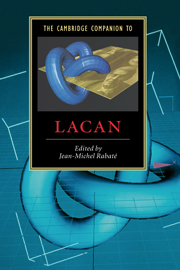Book contents
- Frontmatter
- 1 Lacan’s turn to Freud
- 2 The mirror stage: an obliterated archive
- 3 Lacan’s myths
- 4 Lacan’s science of the subject: between linguistics and topology
- 5 From the letter to the matheme: Lacan’s scientific methods
- 6 The paradoxes of the symptom in psychoanalysis
- 7 Desire and jouissance in the teachings of Lacan
- 8 Lacan and philosophy
- 9 Lacan’s Marxism, Marxism’s Lacan (from Žižek to Althusser)
- 10 Ethics and tragedy in Lacan
- 11 A Lacanian approach to the logic of perversion
- 12 What is a Lacanian clinic?
- 13 Beyond the phallus: Lacan and feminism
- 14 Lacan and queer theory
- 15 Lacan’s afterlife: Jacques Lacan meets Andy Warhol
- Further reading
- Index
- Series List
11 - A Lacanian approach to the logic of perversion
Published online by Cambridge University Press: 28 May 2006
- Frontmatter
- 1 Lacan’s turn to Freud
- 2 The mirror stage: an obliterated archive
- 3 Lacan’s myths
- 4 Lacan’s science of the subject: between linguistics and topology
- 5 From the letter to the matheme: Lacan’s scientific methods
- 6 The paradoxes of the symptom in psychoanalysis
- 7 Desire and jouissance in the teachings of Lacan
- 8 Lacan and philosophy
- 9 Lacan’s Marxism, Marxism’s Lacan (from Žižek to Althusser)
- 10 Ethics and tragedy in Lacan
- 11 A Lacanian approach to the logic of perversion
- 12 What is a Lacanian clinic?
- 13 Beyond the phallus: Lacan and feminism
- 14 Lacan and queer theory
- 15 Lacan’s afterlife: Jacques Lacan meets Andy Warhol
- Further reading
- Index
- Series List
Summary
Few are those who willingly confess that among their shortcomings they lack a sense of humor. Likewise, I have not yet encountered the rare specimen who would admit to being a pervert. This unfortunate state of affairs is due, among other things, to the fact that perversion, even in the Lacanian era, has always remained an outsider. Perversion is not a structure of desire that evokes sympathy or kinship. Moreover, Lacan did not describe perversion with the same plethora of clinical insights that he provided for hysteria, obsessional neurosis, and phobia. He was able to extract from Freud's cases - Dora, the Rat Man, and Little Hans – those strategies that underlie all of psychic life and that therefore no longer need to be perceived in pathological terms: it is inevitable that the human subject will “choose” a neurosis (SE 1, p. 220) enabling him or her to negotiate the thin line between the need to attain erotic gratification and the fear of losing the ability to want. Hence neurotic compromises are deeply ingrained in the fabric of daily life and are therefore no less respectable than any other creative productions. What psychoanalysis can offer, to those who seek its services, are merely alternative pathways that can potentially disrupt the deadly routine of the repetition compulsion.
- Type
- Chapter
- Information
- The Cambridge Companion to Lacan , pp. 191 - 207Publisher: Cambridge University PressPrint publication year: 2003
- 10
- Cited by



